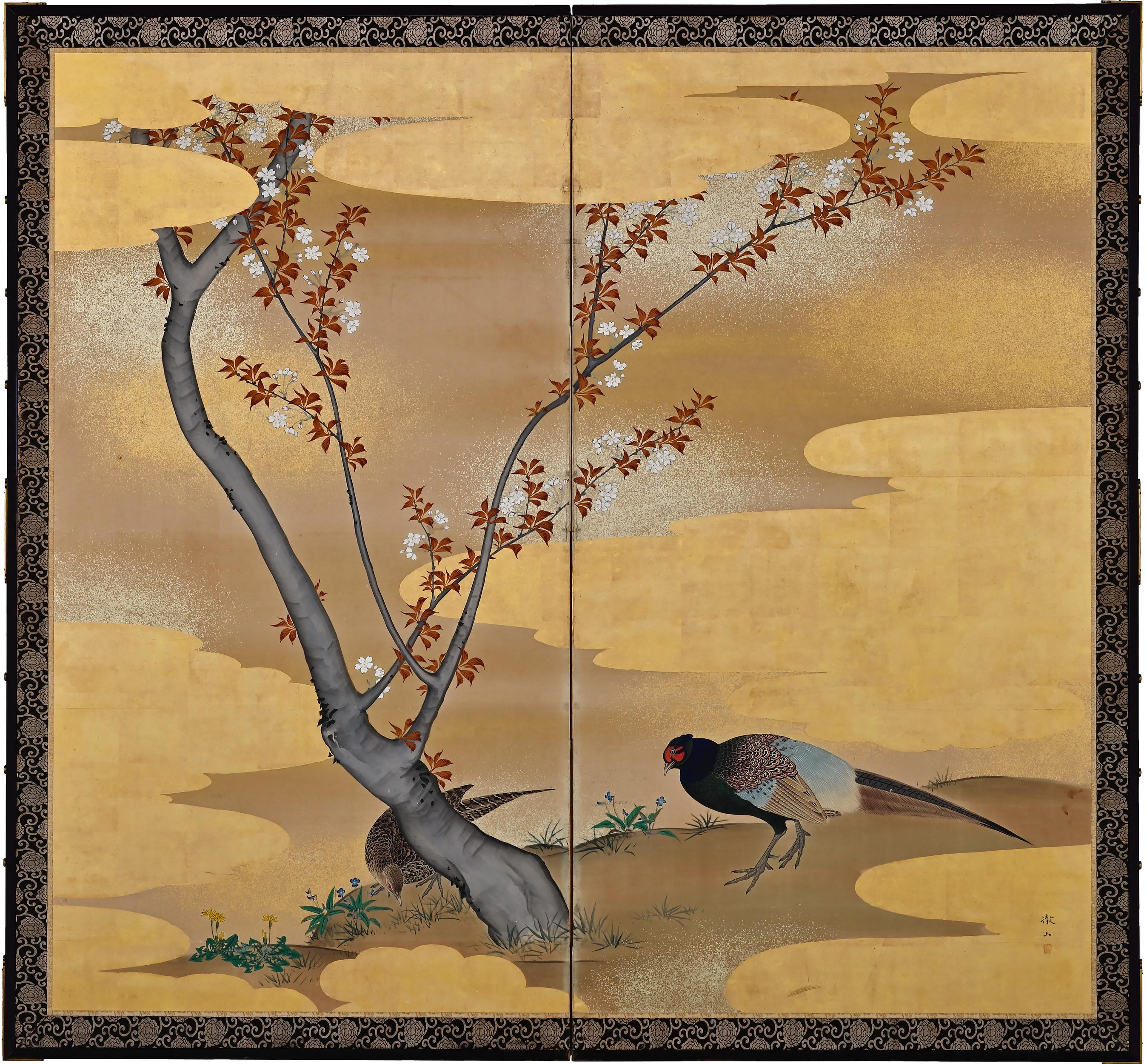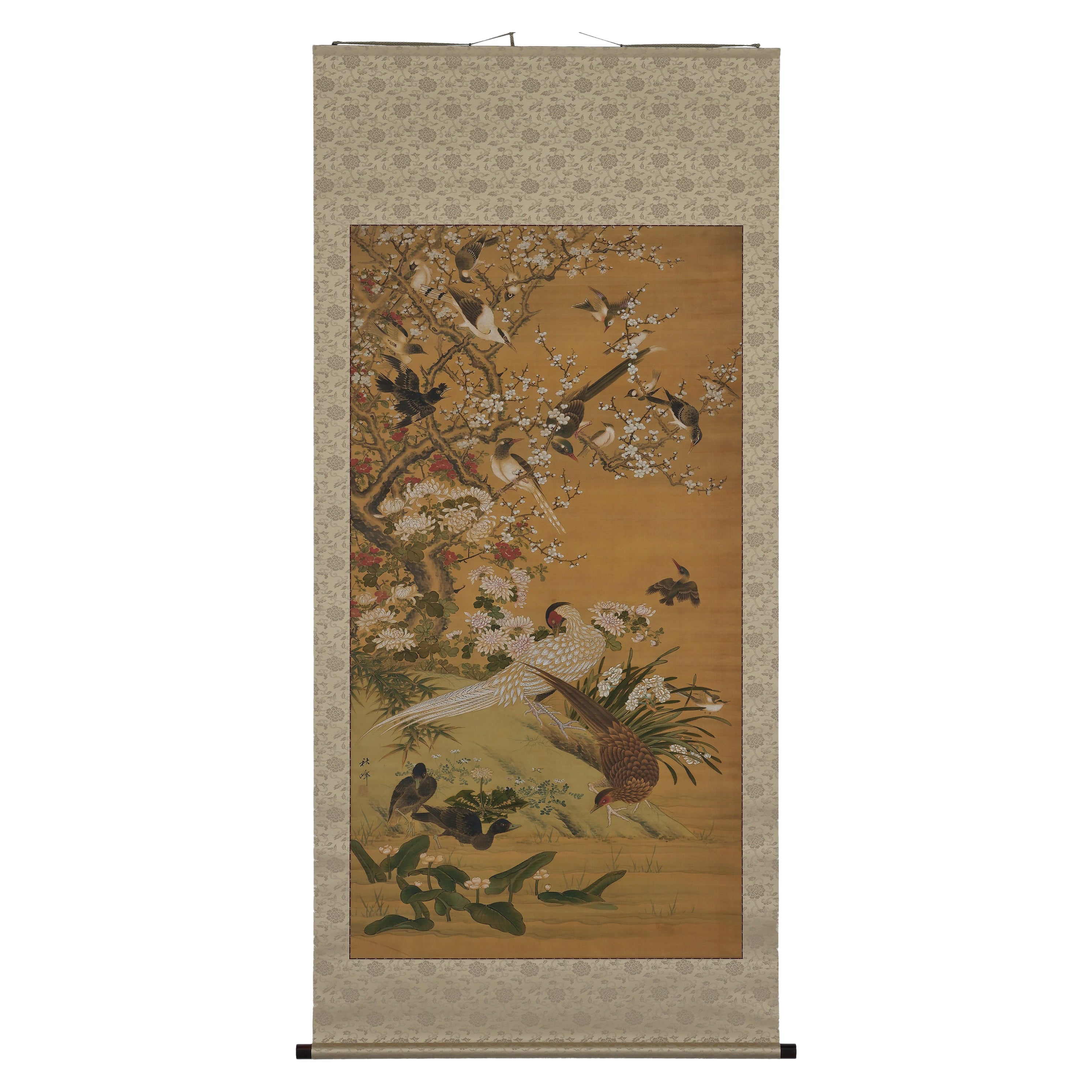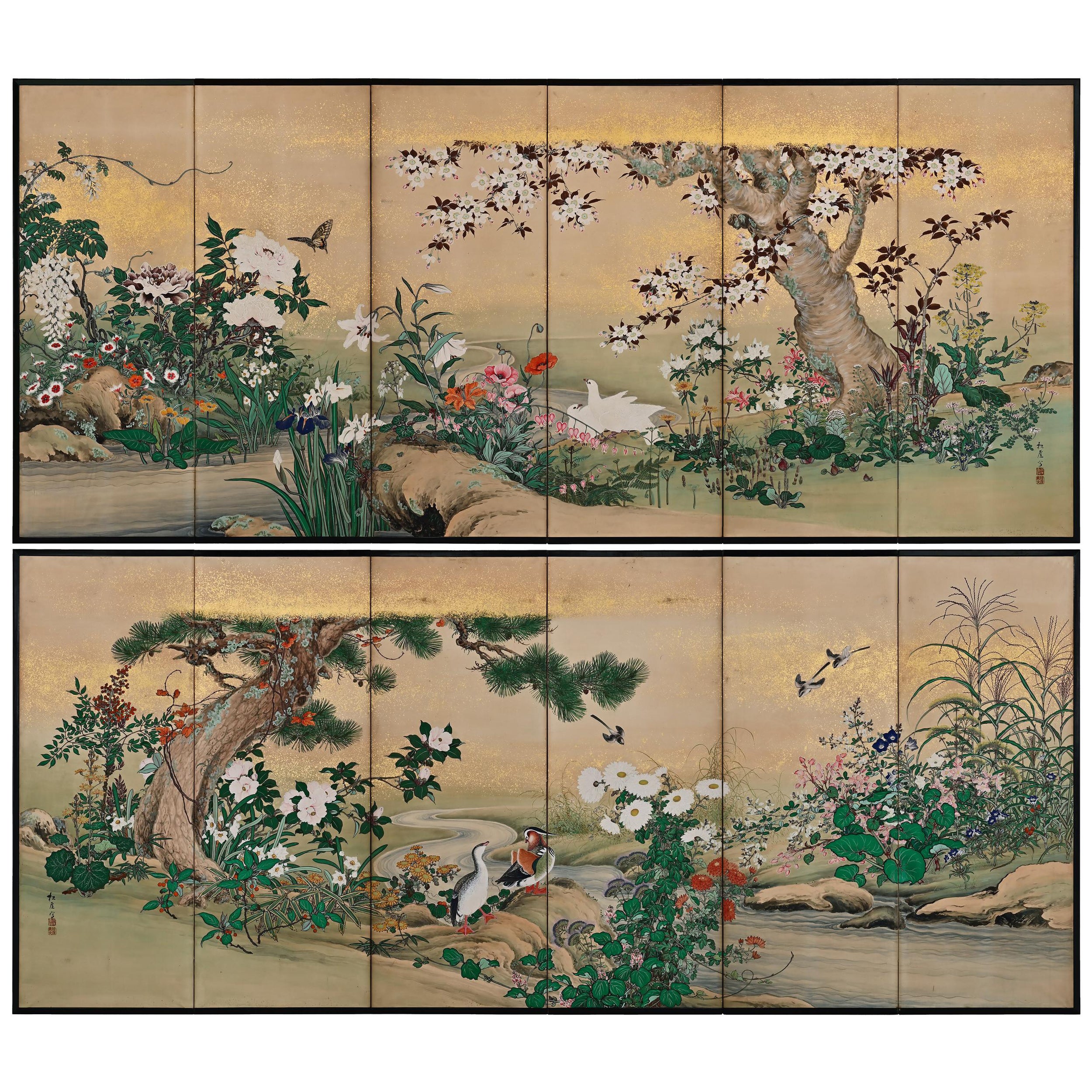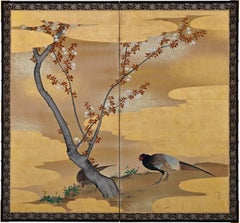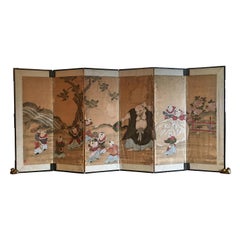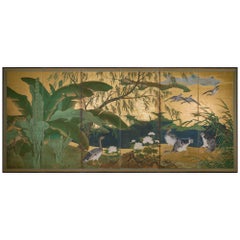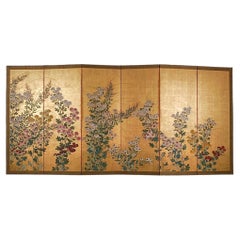Items Similar to Japanese Screen Painting, Early 19th Century, Autumn Flowers by Sakai Hoitsu
Want more images or videos?
Request additional images or videos from the seller
1 of 5
Japanese Screen Painting, Early 19th Century, Autumn Flowers by Sakai Hoitsu
About the Item
A two-fold Japanese screen by the Rimpa school artist Sakai Hoitsu (1761-1828), Japan, 19th century, Edo period.
This small Japanese folding screen painted by Sakai Hoitsu was originally designed as a pair of sliding doors for an alcove or tokonoma. The scene depicts an autumn vine weaving rhythmically through bellflowers (kikyo) and pampass grass (susuki). Kikyo and susuki are two of the celebrated seven grasses of autumn (aki no nanakusa) which were often mentioned in verses of the Manyoshu, the earliest collection of Japanese poetry and song. More than flowers of any other season, autumn grasses washed by rain and bent in the wind are thought to attain a beauty unsurpassed; many feel the same way regarding Hoitsu’s exquisite brushwork and graceful compositions.
A four-fold screen by Hoitsu utilising the almost identical composition is held in the collection of the Miho Museum, Shiga.
Born into the family of the feudal lords of Himeji castle, Sakai Hoitsu had a privileged and cultivated upbringing providing him the opportunity to study Noh drama, haiku poetry, tea-ceremony, music and painting. As was common during the Edo period, Hoitsu began his study of painting with the officially sanctioned Kano school, later receiving influence from and instruction in the contemporary Ukiyo-e, Maruyama-Shijo and Nagasaki styles. Taking tonsure as a monk in 1797 Hoitsu freed himself of his significant familial obligations and immersed himself in the study of the life and art of Ogata Korin (1658-1716). His attraction to Korin was inspired by the fact that a century earlier Hoitsu’s family had been among Korin’s chief patrons, and numerous masterpieces by Korin were preserved in their collection.
In 1815, 100 years after Korin’s death, Hoitsu published Korin Hyakuzu (One Hundred Paintings by Korin), woodblock print reproductions of paintings by the master. Besides honouring Korin in this way, he clearly traced the lineage of what would come to be known in a later age as the Rinpa (Rimpa) school. Hoitsu, while taking Korin’s works as his model, went on to create highly affecting works reflective of the refined tastes of his day.
In recent times the Rinpa (Rimpa) school, which Hoitsu played a pivotal role in developing, has become Japan’s most admired and celebrated school of art.
In 1972 an exhibition entitled ‘Rinpa’ was held to celebrate the 100th anniversary of the Tokyo National Museum.
Commenting on that exhibition the noted scholar James Cahill states “The world of Rinpa is not far from our everyday life. It simply transforms the everydayness into a thoroughly beautiful image. Of all the arts in the world, if one were to cite a decorative style that transcends the ‘simply decorative’ limit, it would be Rinpa. The delicacy, boldness, and impressiveness of Rinpa is a perfect match for works of religious or humanistic content demonstrating highly refined artistry.”
In 2008 the Tokyo National Museum held an exhibition titled ‘Treasures by Rinpa Masters - Inheritance and Innovation’ in which many works by Hoitsu were featured.
In 2011 to celebrate the 250th anniversary of Hoitsu’s birth a broad and scholarly exhibition titled ‘Sakai Hoitsu and Edo Rinpa’ was held at the Himeji City Museum of Art and the Chiba City Museum of Art.
In 2012 the Japan Society held the exhibition ‘Silver Wind: the Arts of Sakai Hoitsu’ in New York. The exhibited works were sourced predominantly from American collections.
In 2015 the Kyoto National Museum held the blockbuster exhibition ‘Rinpa - The Aesthetics of the Capital’. Works by Hoitsu formed a significant part of the exhibition.
Works by the artist can be found in the collections of: Asia Society, New York; Cleveland Museum of Art, Ohio; Etsuko and Joe Price Collection, USA; Feinberg Collection, USA; Gitter-Yellen Collection, USA; Hosomi Museum, Kyoto; Idemitsu Museum of Arts, Tokyo; Indianapolis Museum of Art, Indiana; Kyoto National Museum; Los Angeles County Museum of Art, California; Metropolitan Museum of Art, New York; Minneapolis Institute of Art, Minnesota; Mitsui Memorial Museum, Tokyo; MOA Museum of Art, Shizuoka; Museum of Fine Arts, Boston; Museum of Imperial Collections, Sannomaru Shozokan; Museum Yamato Bunkakan, Nara; National Gallery of Victoria, Australia; Nelson-Atkins Museum of Art, Missouri; New Orleans Museum of Art, Louisiana; Philadelphia Museum of Art, Pennsylvania; Seikado Bunko Art Museum, Tokyo; Smithsonian Museum of Art, Washington D.C.; Tokyo National Museum; Victoria and Albert Museum of Art, London; Worcester Art Museum, Massachusetts; Yamatane Museum of Art, Tokyo.
Dimensions:
Image H 13” x W 51” (32 cm x 129 cm)
Screen H 18” x W 56” (46 cm x 144 cm).
- Dimensions:Height: 18 in (45.72 cm)Width: 56 in (142.24 cm)Depth: 1 in (2.54 cm)
- Style:Edo (Of the Period)
- Materials and Techniques:
- Place of Origin:
- Period:
- Date of Manufacture:circa 1820
- Condition:Repaired. Refinished. Minor losses. Restored and remounted in Kyoto utilizing traditional craftsmen and materials.
- Seller Location:Kyoto, JP
- Reference Number:1stDibs: LU2472319236992
About the Seller
5.0
Recognized Seller
These prestigious sellers are industry leaders and represent the highest echelon for item quality and design.
Established in 2001
1stDibs seller since 2016
70 sales on 1stDibs
Typical response time: 6 hours
- ShippingRetrieving quote...Shipping from: Kyoto, Japan
- Return Policy
Authenticity Guarantee
In the unlikely event there’s an issue with an item’s authenticity, contact us within 1 year for a full refund. DetailsMoney-Back Guarantee
If your item is not as described, is damaged in transit, or does not arrive, contact us within 7 days for a full refund. Details24-Hour Cancellation
You have a 24-hour grace period in which to reconsider your purchase, with no questions asked.Vetted Professional Sellers
Our world-class sellers must adhere to strict standards for service and quality, maintaining the integrity of our listings.Price-Match Guarantee
If you find that a seller listed the same item for a lower price elsewhere, we’ll match it.Trusted Global Delivery
Our best-in-class carrier network provides specialized shipping options worldwide, including custom delivery.More From This Seller
View AllEarly 19th Century Japanese Screen. Cherry Blossom & Pheasants by Mori Tetsuzan
Located in Kyoto, JP
Mori Tetsuzan (1775-1841)
Pheasants and Cherry Blossoms
Two-fold Japanese screen. Ink, color, gofun, gold and silver on paper.
A two-fold Japanese bir...
Category
Antique Early 19th Century Japanese Edo Paintings and Screens
Materials
Gold Leaf
19th Century Japanese Scroll Painting, Birds & Flowers of the Four Seasons
Located in Kyoto, JP
Birds and flowers of the four seasons
Early to mid-19th century
Ink, pigment and gofun on silk
Unidentified artist
Signature: S...
Category
Antique 1830s Japanese Edo Paintings and Screens
Materials
Silk
19th Century Japanese Screen Pair. Flowers & Birds of the Four Seasons
Located in Kyoto, JP
Flowers & Birds of the Four Seasons
Pair of six-fold Japanese Screens. Ink, color, gofun and gold on paper.
Second half of the 19th Centur...
Category
Antique Late 19th Century Japanese Meiji Paintings and Screens
Materials
Wood, Paper
19th Century Japanese Silk Painting by Kano Chikanobu, Phoenix & Paulownia
Located in Kyoto, JP
Birds & Flowers of the seasons
Pheasants & Plum in Snow
Unframed painting. Ink, pigment and gofun on silk
Kano Chikanobu 1819-1888
Signature...
Category
Antique Mid-19th Century Asian Edo Paintings and Screens
Materials
Silk
19th Century Japanese Silk Painting by Kano Chikanobu, Peacock & Bamboo
Located in Kyoto, JP
Birds & Flowers of the Seasons
Pheasants & Plum in Snow
Unframed painting. Ink, pigment and gofun on silk
Kano Chikanobu 1819-1888
Signature...
Category
Antique Mid-19th Century Asian Edo Paintings and Screens
Materials
Silk
19th Century Japanese Silk Painting by Kano Chikanobu, Turtles & Azalea
Located in Kyoto, JP
Birds & flowers of the seasons
Pheasants & plum in snow
Unframed painting. Ink, pigment and gofun on silk
Kano Chikanobu 1819-1888
Signature...
Category
Antique Mid-19th Century Asian Edo Paintings and Screens
Materials
Silk
You May Also Like
Japanese Six Panel Screen with Hotei, Edo Period, Early 19th Century
Located in Austin, TX
A delightful Japanese six panel painted paper screen featuring the beloved figure Hotei, Edo Period, early 19th century.
Hotei, called Budai in China, and known as the Laughing Buddha or Fat Buddha in the West, is considered to be an emanation of Maitreya, the Buddha of the Future.
In Japan, he also holds a special place as one of the Seven Lucky Gods, being the god of fortune, and protector of children.
He is always portrayed as a mirthful and corpulent man, dressed in loose robes that show off his round belly. He carries a sack with him, said to be filled with treasure. As the protector of children, he is often portrayed with them playing on or around him, as he is here. The children portrayed in this screen are dressed in Chinese style clothing...
Category
Antique Early 19th Century Japanese Edo Paintings and Screens
Materials
Silk, Paper
Early 19th Century Japanese Six-Panel Screen, Tropical Garden
Located in Hudson, NY
With a banana leaf palm on the left, at water's edge with geese. Perhaps a scene from the southern islands. Mineral pigments on mulberry paper with gold leaf and a silk brocade border.
Category
Antique Early 19th Century Japanese Paintings and Screens
Materials
Gold Leaf
19th Century Japanese Edo Six Panel Kano School Landscape Screen
Located in Rio Vista, CA
Late Edo period 19th century Japanese six-panel landscape screen featuring a cypress tree over a flowering hibiscus with a pair of hototogisu birds. Kano school painted with ink and ...
Category
Antique 19th Century Japanese Edo Paintings and Screens
Materials
Silk, Wood, Paper
Japanese Six-Panel Screen Byobu With Chrysanthemums And Autumn Grass and Flower
Located in Torino, IT
The 19th Century Six-Panel Japanese folding screen "Byōbu" usually used in the most important Japanese house to stop wind and also to separate different space of the same big room de...
Category
Antique Mid-19th Century Japanese Edo Paintings and Screens
Materials
Gold Leaf
Japanese Four Panel Screen: Autumn Flowers and Moon on Gold
Located in Hudson, NY
Mineral pigments on gold leaf.
Category
Early 20th Century Japanese Paintings and Screens
Materials
Gold Leaf
Late 17th-Early 18th Century Japanese Six-Panel Screen, Battle at Uji Bridge
Located in Hudson, NY
Japanese six-panel screen: Battle at Uji Bridge, the first battle at Uji was in 1180 and it marked the start of the Heike Wars. The Genji troops crossed the...
Category
Antique Late 17th Century Japanese Edo Paintings and Screens
Materials
Gold Leaf
Recently Viewed
View AllMore Ways To Browse
Early 19th Century New York
Japanese Weaving
Japanese Furniture Los Angeles
Pair Of Japanese Paintings
18 Century Reproductions
Four Fold Screen
Japanese Folding Screen Screen
Used Screen Doors
Japanese Folding Screens
Japanese Edo Period Screens
Japanese Screens Flowers
Japanese Screen Silver
Japanese Folding Screen Art
Decorative Folding Screens
Small Asian Screens
18c Painted Furniture
Japanese 19th Century Flower Painting
The Four Seasons 19th Century
